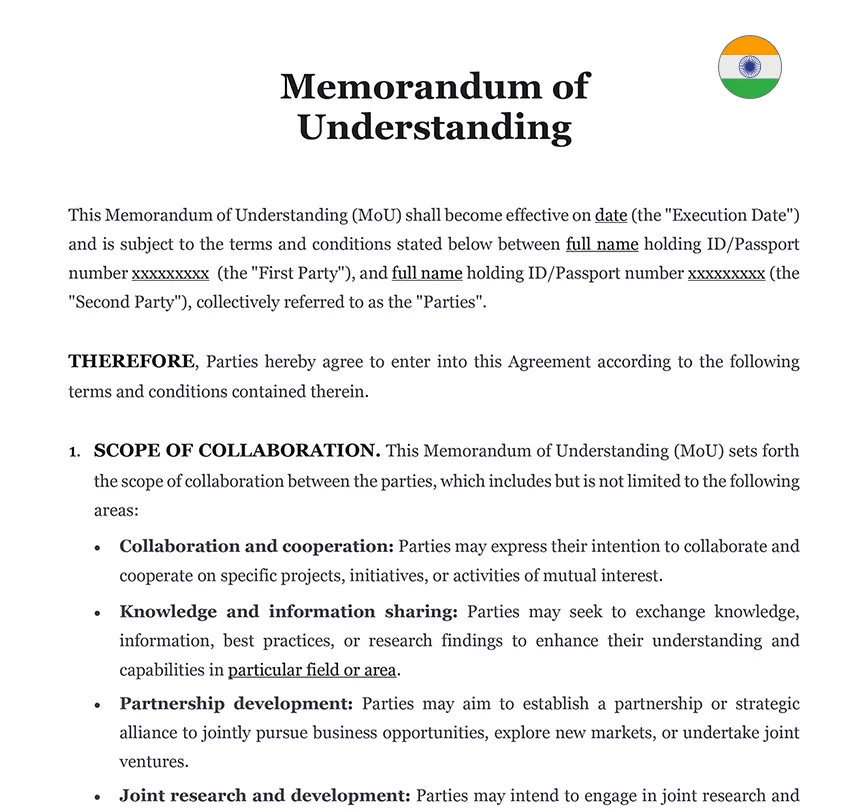Ready to use legal template
Drafted by experienced lawyers
Compliant with Indian law
Ready to use legal template
Drafted by lawyers
Compliant with Indian law
Home › Business contracts › Memorandum of Understanding
Learn more about Memorandum of Understanding (MOU) in India
A Memorandum of Understanding (MoU) is a formal agreement between two or more parties that outlines their mutual intentions and objectives. In India, an MoU is commonly used in business to establish a preliminary understanding before entering into a more detailed contract. It defines the scope of the proposed collaboration, key terms and conditions, roles and responsibilities, and the expected outcome. While not legally binding, an MoU serves as a foundation for future negotiations and sets the framework for a successful business relationship in India.
Table of contents
What is a Memorandum of Understanding?
A Memorandum of Understanding (MoU) is a written agreement between two or more parties that outlines their mutual intentions, objectives, and areas of cooperation. It serves as a preliminary document that sets the foundation for future collaborations, partnerships, or contracts. While an MoU is not a legally binding contract, it expresses the parties’ commitment to work together towards a common goal.
In the context of India, a Memorandum of Understanding holds significance across various sectors, including business, government, education, research, and more. It serves as a tool to formalize understandings, promote cooperation, and establish a framework for future negotiations.
The content of a Memorandum of Understanding typically includes key elements such as the names and identities of the parties involved, the purpose and scope of the agreement, the terms and conditions of collaboration, the expected outcomes, and the timeframe for implementation. It may also cover financial aspects, resource allocation, intellectual property rights, confidentiality provisions, dispute resolution mechanisms, and termination clauses.
One of the key benefits of using a Memorandum of Understanding is its flexibility. It allows parties to outline their intentions and expectations without the formalities and complexities of a legally binding contract. This flexibility enables the parties to explore opportunities, build relationships, and assess the feasibility of a more extensive collaboration before committing to a formal contract.
It is important to note that while an MoU is not legally binding, it still holds ethical and moral weight. Parties should approach the negotiation and execution of an MoU in good faith, ensuring transparency and clear communication. Seeking legal advice and guidance during the drafting process can help ensure that the MoU aligns with Indian laws and regulations and protects the parties’ interests.
In summary, a Memorandum of Understanding serves as a preliminary agreement that captures the intentions and expectations of parties entering into a collaborative effort. It lays the groundwork for future contracts and partnerships while promoting transparency, cooperation, and a shared understanding of the objectives.
What is included in a Memorandum of Understanding?
A typical Memorandum of Understanding includes several key elements. First, it identifies the parties involved in the agreement, providing their names, addresses, and contact information. This section ensures clarity and establishes the parties’ identities.
The purpose and objectives of the agreement are also outlined in the MoU. This section explains the reasons for entering into the agreement and sets out the goals that the parties intend to achieve collectively. It defines the scope of the collaboration, specifying the activities, projects, or initiatives that will be undertaken.
Another important aspect of a Memorandum of Understanding is the description of the roles and responsibilities of each party. This section delineates the contributions, tasks, and obligations that each party will undertake to fulfill the objectives of the agreement. It helps establish accountability and ensures that all parties are aware of their respective roles.
Additionally, the MoU may include provisions related to the timeline and duration of the agreement. It specifies the starting and ending dates, milestones, or any specific timeframes relevant to the collaboration.
Furthermore, financial aspects can be addressed in the MoU, such as the allocation of funds, budgetary considerations, or financial responsibilities of the parties involved. Intellectual property rights, confidentiality provisions, dispute resolution mechanisms, and termination clauses may also be included to protect the parties’ interests.
It is important to note that the content of a Memorandum of Understanding can vary depending on the nature of the collaboration and the specific requirements of the parties involved. Therefore, it is crucial to carefully tailor the MoU to suit the unique circumstances and objectives of the agreement. Seeking legal advice can provide guidance on drafting a comprehensive and effective Memorandum of Understanding that aligns with Indian laws and regulations.
How to write a Memorandum of Understanding?
Writing a Memorandum of Understanding (MoU) requires careful consideration and attention to detail to ensure that all parties involved have a clear understanding of the agreement. Here are some essential steps to follow when drafting an MoU:
1. Identify the parties: Begin by clearly stating the names, addresses, and contact information of all the parties involved in the agreement. This helps establish the identities of the signatories.
2. Define the purpose and objectives: Clearly articulate the purpose and objectives of the collaboration. Specify the goals, activities, and outcomes that the parties intend to achieve together. This section sets the context for the agreement.
3. Outline the scope of the agreement: Provide a comprehensive description of the scope of the collaboration. This includes specifying the projects, tasks, or initiatives that will be undertaken. Clearly define the boundaries and limitations of the agreement to avoid misunderstandings.
4. Clarify roles and responsibilities: Clearly define the roles and responsibilities of each party involved. Outline the tasks, contributions, and obligations that each party is expected to fulfill. This ensures clarity and accountability throughout the collaboration.
5. Include financial considerations: If applicable, address financial aspects such as funding, resource allocation, or financial responsibilities. Clearly state how financial matters will be managed and how expenses or revenues will be shared.
6. Address timelines and milestones: Specify the duration of the agreement and include any relevant milestones or deadlines. This helps create a timeline for the collaboration and ensures that the parties are aware of important timeframes.
7. Include dispute resolution mechanisms: It is advisable to include provisions for resolving disputes that may arise during the course of the agreement. Specify the methods or procedures that parties will follow to resolve conflicts.
8. Consider confidentiality and intellectual property: If necessary, include provisions to protect confidentiality and address intellectual property rights. This ensures that sensitive information is safeguarded and intellectual property is appropriately managed.
9.Review and finalize the MoU: Carefully review the MoU to ensure that all details are accurate, consistent, and aligned with the intentions of the parties involved. Seek legal advice if necessary to ensure compliance with Indian laws and regulations.
Remember, a Memorandum of Understanding is a flexible document that can be tailored to the specific needs and objectives of the parties involved. It is essential to maintain clear and open communication during the drafting process to ensure that all parties are satisfied with the terms and conditions outlined in the MoU.
What to do if one party refuses to sign?
If one party refuses to sign a Memorandum of Understanding (MoU), there are several steps that can be taken to address the situation. Firstly, it is essential to understand the reasons behind the refusal. Open communication should be initiated to discuss concerns, clarify misunderstandings, or negotiate specific terms. Parties can consider revising the MoU to address objections and find mutually agreeable solutions. If the refusal persists, seeking mediation or alternative dispute resolution methods can help facilitate discussions and find a resolution. In some cases, it may be necessary to explore legal options and consult with legal professionals to determine the best course of action. Ultimately, the goal is to find a compromise that respects the interests of all parties involved and enables the MoU to move forward successfully.
What are the advantages of a Memorandum of Understanding?
A Memorandum of Understanding (MoU) offers several advantages that make it a valuable tool in business relationships and collaborations. Some of the key advantages of a Memorandum of Understanding are:
1. Clarity and shared understanding: An MoU helps establish a clear understanding between the involved parties regarding their objectives, roles, and responsibilities. It outlines the scope of the agreement and sets expectations, reducing misunderstandings and potential conflicts.
2. Flexibility: MoUs are typically more flexible than formal contracts, allowing parties to customize and tailor the agreement to their specific needs. It provides room for negotiation and adjustment as circumstances change or new opportunities arise.
3. Non-binding nature: MoUs are often non-binding, meaning they do not create legally enforceable obligations. This characteristic allows parties to engage in preliminary discussions, collaborations, or pilot projects without the full commitment and legal implications of a formal contract.
4. Memorandum of Cooperation: MoUs can facilitate collaborations between organizations, governments, or entities by establishing a framework for cooperation. It enables parties to work together, share resources, exchange knowledge, and jointly pursue common goals.
5. Memorandum of Intent: In certain situations, an MoU can express the intention of parties to engage in future negotiations or enter into a more comprehensive agreement. It serves as a preliminary step to formalize a business relationship and can help build trust and confidence between parties.
6.Time and cost-effective: Compared to lengthy and complex contracts, MoUs are often quicker to draft and execute. They can be a cost-effective way to initiate partnerships, joint ventures, or other business arrangements, particularly when parties are in the early stages of collaboration.
By leveraging the advantages of a Memorandum of Understanding, businesses and organizations can foster effective partnerships, promote cooperation, and lay the foundation for more formal agreements in the future.
Can a Memorandum of Understanding be terminated?
Yes, a Memorandum of Understanding (MoU) can be terminated under certain circumstances. While an MoU is a non-binding agreement that sets out the intentions and understanding between parties, it does not have the same legal enforceability as a formal contract. However, it is still important to follow proper procedures when terminating an MoU to avoid any misunderstandings or potential legal implications. Here are some key points to consider:
1. Mutual agreement: The termination of an MoU typically requires the mutual agreement of all parties involved. It is important to communicate and discuss the decision to terminate the MoU with the other party/parties. This can be done through written correspondence or in a meeting where all parties are present.
2. Notification period: It is advisable to include a provision in the MoU that outlines the notice period required for termination. This allows parties to have sufficient time to adjust their plans or seek alternative arrangements. The notice period should be clearly defined in the MoU and agreed upon by all parties.
3. Formal notice: The termination should be communicated formally in writing to all parties involved. The notice should clearly state the intention to terminate the MoU and provide details regarding the effective date of termination.
4. Consequences of termination: The MoU may specify any consequences or obligations that arise upon termination. This may include the return of any shared resources, confidentiality obligations, or obligations to refrain from competing with each other.
5.Transition plan: If the MoU involves ongoing activities or projects, it is important to develop a transition plan to ensure a smooth handover or completion of any outstanding tasks. This plan can help minimize disruptions and facilitate the transfer of responsibilities to alternative arrangements, if necessary.
It is important to note that while an MoU may be terminated, parties may still be bound by any obligations or commitments made during the course of the agreement. Therefore, it is advisable to seek legal advice to understand the specific implications of terminating an MoU in your jurisdiction and to ensure compliance with any contractual or legal obligations.
Memorandum of UnderstandingDrafting
Ask our corporate experts to draw up your own tailor-made contract
Memorandum of Understanding (MOU)Template (.docx)
Save on attorney fees
310 client reviews (4.8/5) ⭐⭐⭐⭐⭐
Share information
Why Themis Partner ?
Make documents forhundreds of purposes
Hundreds of documents
Instant access to our entire library of documents for India.
24/7 legal support
Free legal advice from our network of qualified lawyers.
Easily customized
Editable Word documents, unlimited revisions and copies.
Legal and Reliable
Documents written by lawyers that you can use with confidence.




